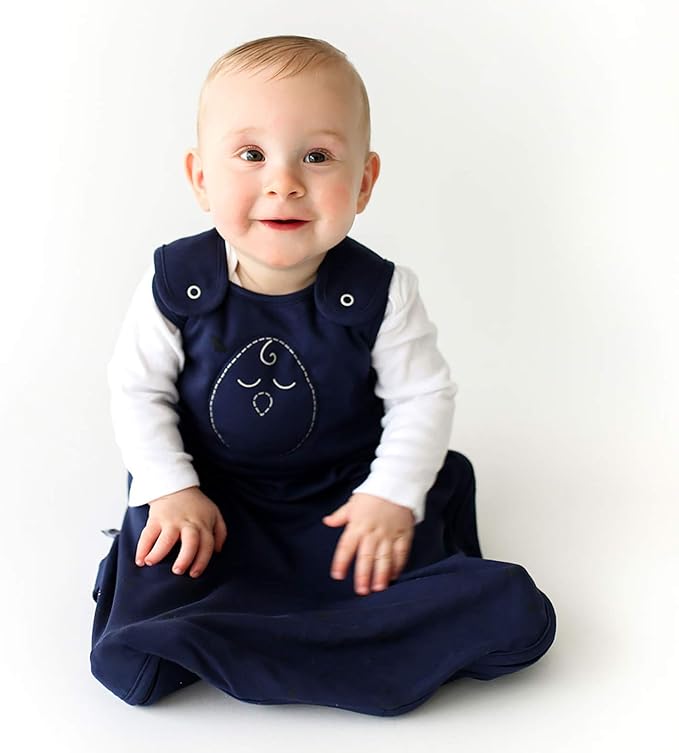Mastering Sleep Training: Gentle Methods for a Restful Night
As a parent, one of the most common challeneges or question i come accross is why wont my baby wont sleep in a bassinet? There are various different sleep training methods which when used correctly can help your baby establish healthy sleep patterns, which is essential for their growth and development. In this article, I will provide an overview of sleep training, its benefits, and some useful tips for parents who want to try it.
In This Article
Understanding the Importance of Safe Sleep
As a parent, one of our primary concerns is ensuring the safety and well-being of our newborn. A significant part of this is understanding and implementing safe sleep training methods, which are crucial for the health and development of our baby. The concept of safe sleep revolves around creating an environment that minimizes risks associated with infant sleep, particularly during the first year of life.
Why Safe Sleep for Babies is Critical
Prevention of Sudden Infant Death Syndrome (SIDS): SIDS, also known as crib death, is the sudden, unexplained death of an infant younger than one year old. While the exact cause of SIDS is unknown, safe sleep practices have been shown to significantly reduce the risk. This includes using a bassinet or crib with a firm mattress, keeping the sleep area free of pillows, toys, and loose bedding, and placing the baby on their back to sleep.
Avoidance of Accidental Suffocation: In an adult bed, there’s a higher risk of accidental suffocation due to soft bedding, pillows, or even a parent inadvertently rolling over onto the baby. A bassinet provides a safer alternative with its firm mattress and enclosed space, designed specifically to meet an infant’s sleep needs.
Promotes Better Sleep Habits: Introducing a bassinet as the primary sleep environment helps in establishing healthy sleep routines for the baby. This environment is free from the disturbances that might occur in an adult bed, like differing sleep schedules and movements.
What is Sleep Training?
Sleep training is a method that helps babies learn to fall asleep and stay asleep on their own. It involves teaching your baby to self-soothe and settle down without relying on external aids, such as rocking or feeding. Sleep training methods vary, but they typically involve a routine that helps your baby recognize when it’s time to sleep.
What are the main Sleep Training Methods:
The Ferber Method (Progressive Waiting)
- Science Behind It: This method, developed by Dr. Richard Ferber, is rooted in the idea that babies can learn to self-soothe and fall asleep on their own if given the chance. It involves letting your baby cry for progressively longer intervals before comforting them.
- Technique: Begin by putting your baby into the bassinet awake, leaving the room after saying goodnight. If the baby cries, wait for a predetermined short amount of time before checking in. Extend the waiting time between each check-in.
- How to Implement: Over several nights, gradually increase the time you allow your baby to cry before checking in. For instance, on the first night, you might wait 3 minutes, then 5 minutes, then 10 minutes. By the third or fourth night, you might start at 10 minutes.
- Positive Parenting Alignment: The Ferber sleep training method has faced criticism for being harsh as it involves letting the baby cry. Some proponents argue it teaches independence, but many adherents of positive parenting find it challenging because it can feel like withholding comfort.

Chair Method (Fading)
- Science Behind It: Parents gradually “fade” out of the baby’s sleep routine by sitting in a chair next to the bassinet and moving farther away each night. The idea is to give babies the reassurance they need while helping them build independence.
- Technique: As your baby is getting ready to sleep, sit in a chair next to the crib. Each night, move the chair a bit further away until you’re out of the room.
- How to Implement: Start by sitting right beside the crib until your baby falls asleep. The next night, move the chair a few feet away. Continue this progression until you’re out of the room and your baby is falling asleep on their own.
- Positive Parenting Alignment: Generally in line with positive parenting, as it’s a gentler approach that balances independence with comfort.
Pick Up/Put Down Method
- Science Behind It: Every time the baby cries, parents pick them up to comfort them and then put them down as soon as they’re calm. The process is repeated until the baby can sleep without being picked up.
- Technique: Respond to your baby’s cries by picking them up, but as soon as they calm down, put them back into the bassinet.
- How to Implement: This can be a bit repetitive, especially in the beginning. When the baby cries, pick them up and soothe them. Once they’re calm, even if not fully asleep, place them back in the crib. Repeat until the baby can sleep without needing to be picked up.
- Positive Parenting Alignment: This sleep training method aligns with positive parenting, as it emphasizes responsiveness and understanding of the child’s cues.
No Tears Method:
- Science Behind It: Advocates believe in comforting the child whenever they cry, fostering a sense of security. The belief is that babies will naturally develop self-soothing abilities when they’re emotionally ready.
- Technique: This method is about comforting your baby immediately when they cry or show signs of distress.
- How to Implement: Instead of letting your baby cry it out, you’d use soothing techniques like rocking, singing, or patting to help them fall asleep. Over time, you’d gradually decrease these interventions, trusting that your baby will learn to self-soothe without crying.
- Positive Parenting Alignment: This sleep training method aligns closely with positive parenting principles as it prioritizes emotional well-being and connection between parent and child.
The “5 S’s” Method (from Dr. Harvey Karp)
- Science Behind It: Based on recreating sensations from the womb (swaddle, side/stomach position, shush, swing, suck), this method believes in the power of familiarity to comfort and soothe newborns.
- Technique: Use the five S’s – Swaddle, Side/Stomach position, Shush, Swing, and Suck.
- How to Implement:
- Swaddle: Wrap your baby securely in a blanket to replicate the snug feeling of the womb.
- Side/Stomach Position: Lay your baby down on their side or stomach (though for safe sleep, babies should be placed on their backs). This position can be comforting, especially during fussy times.
- Shush: Create a shushing sound near your baby’s ear. This mimics the white noise of the womb.
- Swing: Gentle rocking motions can soothe a fussy baby. This can be achieved by holding the baby and swaying, using a baby swing or a rocking bassinet
- Suck: Let the baby suck on something, whether it’s a pacifier, their thumb, or a bottle.
- Positive Parenting Alignment: Aligns with positive parenting since it promotes understanding the baby’s perspective and provides comfort based on their innate preferences.
Sleep Training Programmes
As parents, our well-being is deeply tied to our children’s. When they can’t sleep, neither can we, leading to exhaustion and stress for the whole family. Sleep isn’t just a luxury; it’s essential for both health and development.
This is where Mary-Ann Schuler’s Baby Sleep Miracle steps in. One of the best sleep training methods I have come accross.
Baby Sleep Miracle is a comprehensive guide tailored for parents who face challenges with their child’s sleep. Designed by a fellow parent and physologist, Mary-Ann Schuler, this program offers research-backed methods to instill healthy sleep habits in children, catering to newborns up to five-year-olds.
Highlights of the guide include:
- The significance of sleep for a baby.
- Relating developmental stages to sleep patterns.
- Understanding and addressing sleep deprivation dangers.
- Preparing both parent and child for the sleep training journey.
- Age-specific sleep guidelines and rules.
- The value of scheduled napping and consistent feeding.
- Creating a sleep-conducive environment for the baby.
The Baby Sleep Miracle isn’t just about putting your baby to sleep; it’s about understanding the underlying causes of sleep disruptions. Whether you’re a new parent or have a toddler resisting bedtime, this guide is a resource to help you navigate these challenges.
Its easy-to-follow structure, combined with actionable advice, makes it a worthwhile investment for families. Plus, with a 60-day money-back guarantee, there’s no risk involved. However, like any guide, its success relies on the commitment of the reader to actively implement the strategies.
Don’t let another restless night pass. Dive into the Baby Sleep Miracle and embark on a journey towards peaceful nights for both you and your child.
Benefits of using Sleep Training Methods for babies
Sleep training methods have several benefits for both babies and parents, they include:
Better Sleep Quality: Sleep training can help your baby establish healthy sleep patterns, resulting in better sleep quality. A well-rested baby is more alert, active, and happy during waking hours, which is essential for their development.
Improved Cognitive Functioning: Sleep is crucial for cognitive functioning, and babies need plenty of it for their brains to develop properly. Sleep training helps your baby get the amount of sleep they need to optimize their cognitive abilities.
Better Feeding Habits: Babies who get enough sleep are more likely to have better feeding habits. They are more alert and focused during feeding times, which can lead to better feeding and improved weight gain.
Less stress for parents/caregivers: Sleep training can be a challenging process, but once it is successful, it can greatly reduce stress levels for parents and caregivers. When babies learn to sleep on their own, parents can get the rest they need and have more time to focus on other tasks or simply relax.
Better daytime behaviour: When babies get adequate sleep, they are generally happier, more alert, and less fussy during the day. They are also more receptive to learning and playing, which is crucial for their cognitive and physical development
Reduced Risk of SIDS: Sleep training can reduce the risk of Sudden Infant Death Syndrome (SIDS). A baby who is trained to sleep on their back and in their own space is less likely to suffer from SIDS.
Improved parent-child bonding: Sleep training can also improve the bond between parents and their babies. When babies learn to soothe themselves to sleep, they become more independent and confident. This, in turn, can lead to a stronger bond between parents and their babies.
Top Tips for Implementing Sleep Training Methods
If you’re considering sleep training, here are some of my top tips to help you get started:
Start Early
The earlier you start sleep training, the easier it will be for your baby to learn healthy sleep habits. Ideally, you should begin sleep training between 4 and 6 months of age, when your baby is developmentally ready to sleep for longer periods of time.
Use a Baby Sound Machine
Also known as a white noise machine or sleep sound machine, these produce soothing sounds to help babies (and adults too) fall asleep and stay asleep
Establish a Consistent & Calming Bedtime Routine
Consistency is key when it comes to sleep training. Stick to a regular sleep schedule, and be consistent with your approach to sleep training. This means using the same techniques every night, and not deviating from your routine.
A calming bedtime routine can help signal to your baby that it’s time to sleep. This could include a warm bath, a massage, reading a story, or singing a lullaby. Keep the routine consistent and low-key, and avoid stimulating activities like playing or watching TV.
Consider using a Weighted Sleep Sack
The gentle weight mimics the sensation of your palm by adding a lightly touched-feeling area on the chest. This can help babies to self-soothe and sleep longer when not in your arms.
Be patient and persistent
Sleep training is a process, and it may take some time for your baby to learn healthy sleep habits. Be patient and persistent, and don’t give up if you don’t see immediate results. Stick to your routine, and over time, your baby will learn to fall asleep on their own and sleep through the night.
There are many different sleep training methods to choose from, and what works for one family may not work for another.
Closing Thoughts From Me
Implementing Sleep training methods can be a challenging process, but it’s also a critical part of helping your baby develop healthy sleep habits. By establishing a consistent sleep schedule, using a calming bedtime routine, and being patient and persistent, you can help your baby learn to fall asleep on their own and sleep through the night. Remember to choose a sleep training methods that work for you and your baby, and be consistent with your approach to sleep training. With time and patience, you can help your baby develop healthy sleep habits that will last a lifetime.







